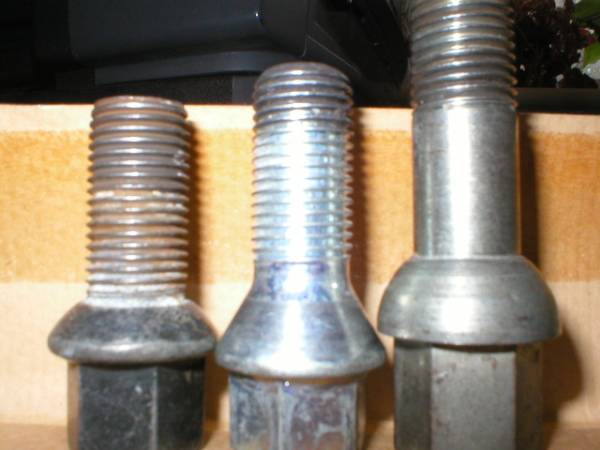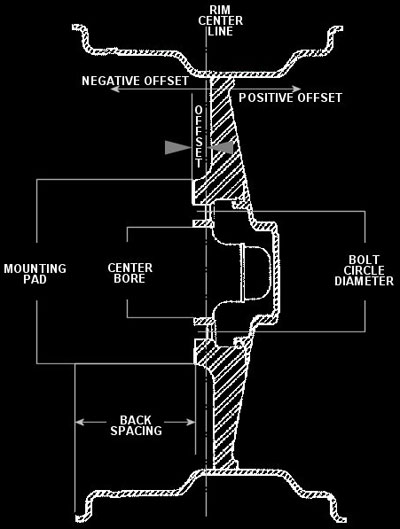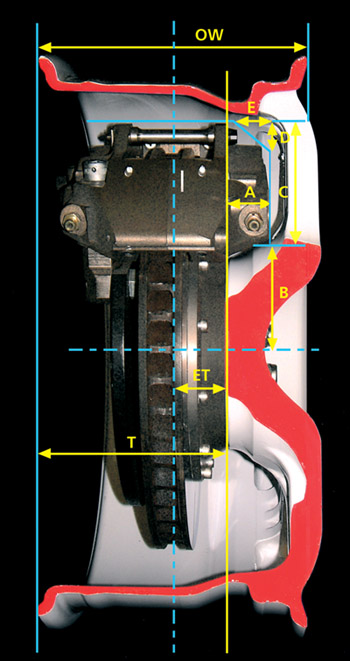Wheels & TyresIntroduction There were two styles of wheel fitted by the factory to the S2. The original 5-spoke design (photos to follow) looks a little dated now. This was fitted to the 3B engined Coupes. Some very early Avants (with the obligatory ABY engine) also had the 5-spoke wheel, so its fair to assume that some of the earliest ABY engined Coupes may also have had them fitted in the factory. These would be early MY93 models with a 'P' in the VIN. The vast majority of ABY engined cars left the gates at Ingolstadt fitted with the deliciously styled 'Avus' 6-spoke alloy which still look good ten years on. The basic rule is to always fit the same wheels
and tyres front and rear on the S2 so that the Torsen based quattro transmission
is not fooled into thinking there are speed differences between front
and rear axles. Failure to observe this could cause serious damage to
the centre differential. More about aftermarket wheel and tyre choices
below
. Specifications The original 5-spoke has dimensions of 7Jx16
whilst the Avus is a little wider with 7.5Jx16. The offset (ET) is 37mm
in both cases. More about offset below
. Original tyres were sized at a conservative 205/55 and carried
a 'Z' speed rating. The gearing and final-drive ratios on both the 5-speed
and 6-speed transmissions is such that top gear gives a speed of 24.7mph
per thousand RPM of the engine. More about understanding those calculations
to come in the transmission section. A full list of related wheel specifications
are provided in the table below.
The Audi RS2, with its Porsche parentage, has different wheel dimensions to accomodate the 'Cup' style alloys it was fitted with originally. Most notable is the 5x130 bolt pattern which is normal for Porsche. Also of interest is the oddball 7Jx17 wheel fitted to the RS2 which was fitted with a special Dunlop 8000 series tyre sized as 245/40R17. This tyre is NLA and the generally accepted wisdom is that 225/45R17 is the correct tyre for that wheel as the original '245' was somewhat narrower than its claimed dimension. When RS2 owners are shopping for new wheels, they have to look out for Porsche styles and fitments. This poses problems for RS2 owners wanting newer wheel styles from the VW/Audi family as they, and replicas, are generally never manufactured with the 5x130 pattern. Another problem for RS2 owners is that Porsche wheels more commonly have a centre bore diameter of ~71mm, which needs to be enlarged for the RS2 application.
The factory Audi wheels need bolts with 'radius' seats for proper installation. Many aftermarket wheel bolts, stud kits and locks have 'tapered' seats. These must NEVER be used with the factory Audi wheels... unless you like the thought of your wheels working themselves loose. Note also that many aftermarket wheels are manufactured to work with tapered bolts, so please check this before fitting. The image below shows the differences quite clearly. 
Modifications & Aftermarket options There are umpteen aftermarket wheel and tyre options suitable for the S2 as the 5x112 bolt pattern is a very common fitment on Audis of new and old. Notable exceptions are the Audi TT and Audi S3 as their parentage is more related to VW which use a 5x100 bolt pattern. When upsizing wheels, many readers will know about the necessity to reduce the tyre profile in order to maintain the same rolling circumference as what the speedometer is calibrated to expect. A smaller circumference will result in lower top speed, whilst a larger circumference results in higher top speed. No hard sums are needed to understand that. This is all about revs per mile again. A number of tyre calculators are available on-line for this purpose - some brand specific ones will give accurate figures for specific tyres. But the following is a rough guide to some options that work. Do your homework and/or make measurements yourself if in any doubt. Here's a good tyre calculator that gives generic info and will advise the error introduced on the speedometer. Some indicative information is provided in the table below:
NOTE - ALWAYS remember
that same-sized tyres of different brands and types can have different dimensional
information in reality. The above table is just a guide based on nominal
calculations from the claimed tyre size. Try and stay within about 1% of the original wheel circumference for road use. Much larger circumference might cause clearance issues or get you unwittingly caught by a speed trap. Also - Always check that bolts are compatible with the wheels in question... See above note on 'tapered' and 'radiused' wheel bolts. The reputed German tuning company MTM discovered that the S2's natural tendency to understeer could be reduced by fitting wider front tyres to provide better balance of traction. The S2 forum has one notable member in the UK who has successfully proved this theory on his S2 Avant with a particularly radical wheel and tyre combination that achieves this. A ~1% circumference difference exists between front and rear, but this is thought to be well within the capabilities of the Torsen centre differential. It's easy to figure that such a difference would be present with normal tyre wear and tear anyway. The wheel tyre configuration used on this S2 Avant to very good effect, providing more balanced cornering, is as follows: Front - 255/35 Continental ContiSport-2
fitted to OZ Vela 8Jx18 rims with ET32 No doubt some readers will raise eyebrows
at fitting a 255 tyre onto an 8J rim - but apparently it can just be
done. Note the reduced wheel offset at the rear to provide sufficient clearance
on the Avant's rear suspension with an 8x18 tyre. More about offsets below... It is important to understand the wheel parameter known as 'offset'. Normally measured in millimetres, this dimension is the distance from the centre line of the wheel to the mounting face where it connects with the hub. A wheel with zero offset has the hub face exactly in line with the wheel centre. But in the real world, there are essentially two types of offset - NEGATIVE offset is when the hub face is more INBOARD than the wheels centre line. So for any given wheel size, an increase in negative offset moves the wheel closer to the outside, whilst decreased negative offset moves the wheel closer to the inboard side. The figure below nicely depicts such a negative offset wheel. When studying this image, mentally picture the hub face where it meets the wheel mounting pad as the fixed point. 
The Coupe and Avant/Sedan have different rear suspension and clearance issues, so a wheel tyre combination that works on the Coupe may not be suited to the Avant or Sedan. In time, a table will be added here to provide real world data on some of the typical (and extreme) wheel/tyre combinations which have been proven to work on each body shape. For now, a reasonable guide is ET=35 on 17 inches, ET=35 or 32 on 18 inch wheels, ET=32 or 30 on 19 inch wheels. Don't take my word for it though. Make some measurements or ask some questions on the fabulous S2 forum . In order to measure offset on a bare wheel, two measurements are needed. A straight edge and a tape measure or steel rule are all the equipment that is required. 1. Measure the wheels overall width (W) between the edges of the rim. 2. Working from the inboard side of the wheel, use the straight edge to establish the distance from the inboard edge to the wheel's mounting face. We can denote this 'backspace' measurement as 'B'. 3. If B is greater than half of W, then the offset is positive. 4. If B is less than half of W, then the offset is negative. This is NOT a wheel destined to fit the S2 without serious modifications. 5. Calculate offset,
normally expressed in mm, as ET = B
- (W/2). When estimating any clearance issues with other wheels, always remember to take the actual width of the wheel into account. For example, increasing wheel size from 7J to 8J adds ~25mm of width, or approx 12.5mm on each side of the wheels centre line. If the wheels positive ET is reduced from 37 to 35 it would move the wheel centre-line by 2mm towards the outside edge. This means that the wheel would effectively be wider by ~10.5mm on the inside and ~14.5mm on the outside edge. This is a choice we know works fine on all of the S2 variants. Conversely, a poor choice of wheel would be
the 'neu' S4 or S6 Avus rims in 8Jx17 format - some of these have a positive
ET of 45mm. This moves the wheels centre-line a whopping 8mm towards the
inside, which causes interference with the suspension components (tie-rod
ends to be precise). The only way to work around this is to fit an 8mm
hub spacer. Such practice is not ideal as it requires longer wheel bolts
and can place higher loads on the wheel bearings.
However, the only real solution is a stud conversion kit. Studs with an M14x1.5 thread are required. A length of 50mm is nominally required, but you should check with specific wheels before ordering... and don't forget the correct 'radius' or 'taper' seats on the nuts... and the appropriate locknuts of course. Apparently, the use of Porsche hubs on the RS2 brought with it the advantage of a wheel stud configuration. A super light alloy material is used to make the wheel nuts for Porsche and the RS2. When you hold them you would swear they are a toy-like plastic material. They are incredibly light. I'm told there is a need to keep them well lubricated with copper grease to prevent some weird corrosive chemical reaction that causes the wheel nut to corrode quite heavily. Now you know ! Big Brake Considerations One very good reason for fitting larger wheels to the S2 is to fit much larger brakes. However, be advised that not all wheels can accomodate the same big-brake configurations. This is because of differences in clearance between the discs, calipers and wheel spokes. The figure below depicts the clearance quite nicely. I found this cutaway image for a wheel with positive offset on Compomotive's web site where you can understand more about dimensions A-E shown below. They make some nice wheels too ! 
The original 16" 5-spoke wheel is particularly bad in this regard. The largest brake upgrade that it can accomodate is the Hi-Spec kit based on Monster-4 calipers and Audi 314x30 discs. The 16" Avus is much more amenable to brake upgrades being able to accomodate Audi 323x30 discs with Porsche 996 4-pot calipers using RS2 carriers. More about this to come in the Brakes chapter ! If you need brakes bigger than 323x30 then 17" or larger alloys will be required. |
||||||||||||||||||||||||||||||||||||||||||||||||||||||||||||||||||||||||||||||||||||